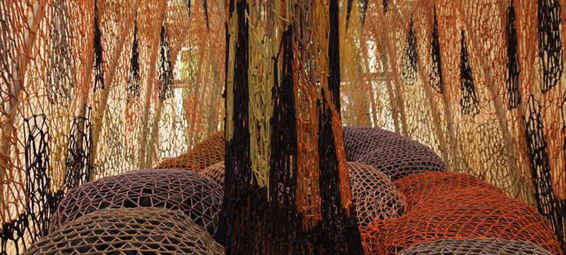The most enduring image of Ernesto Neto that remains after his weekend visit to Dallas for the opening of his exhibition, Cuddle on the Tightrope, at the Nasher Sculpture Center came during the opening reception. As rain began to drizzle down on the grounds of the Nasher garden, suited patrons and women in gowns squeezed underneath the overhang of Renzo Piano’s building, clutching their cocktails. Meanwhile, the artist, with his windblown curly grey locks falling down on his round, grinning face, darted through the crowd looking for sympathetic souls. “We must dance,” he told the local artists, writers, and curators he had only just met during his short stay in town. “There is no one dancing for the band.”
Neto’s enthusiasm for a good time is renowned. He hosts a New Years Eve party on the beach of his native Rio de Janeiro known for mixing notable jet setters on the international art circuit with local beach bums and homeless people who wander onto the scene. This playful openness comes through in much of the artist’s installations, pieces that invite the viewer to interact, enter, or pass through the work. At the Nasher, Neto’s Kink is a long net-like bridge that stretches from one end of the gallery room to another. Climbing through it, as viewers are invited to do, you feel a little like you are a kid making your way through a jungle gym at Chuck E. Cheese. But the structure itself, a complex interlacing crochet of rope, suspended from arching steel supports, packed with plastic balls, hides a slyly monumental presence, large-scaled and voluminous, yet seemingly weightless, its elegant form ever-shifting with the viewer’s changing perspective.
I conducted my interview with Neto inside Kink, and sprawled out in the heart of the sculpture, the piece seemed to reveal another referential characteristic: a beach-like setting, a place of idle leisure in the center of a museum. As we spoke inside Kink, our conversation became increasingly relaxed and candid. It was the sculpture at work.
FrontRow: All your work reacts to or considers the space in which it is installed. How did you think about approaching the Nasher?
Ernesto Neto: At first, I didn’t have an image from the building; I had an image from the collection inside of the building. So I saw a painting and sculptures – many vertical sculptures. And I was seeing this verticality, and I was feeling that I should break this verticality. And then when I came here for the first time, and I had no idea it was such an incredible and amazing building with soft architecture and really cozy, in a way. I arrived fromRio De Janeiro here, and I went to this hotel, theBelmont, and then I saw the sun rising and there was this very long view of Dallas neighborhoods and the sky was kind of blue and pink. It was really amazing. And then I came here.
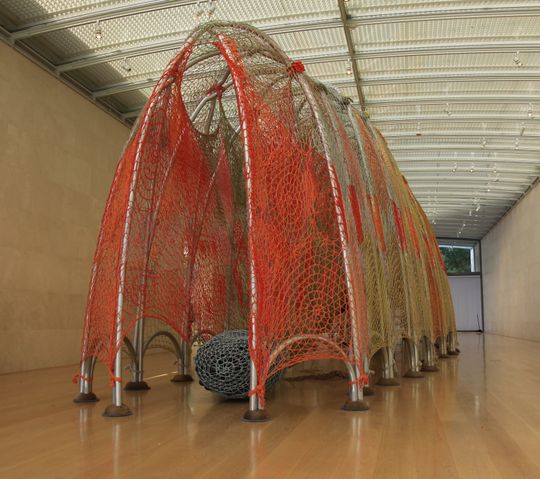 The rooms are in a position to the collection in such a way. They are very length-orientated; you go in and out and through the center of this length. This is the same kind of structure as the Brazilian pavilion inVenice– the entrance is always in the center. You cross the room and exit in the center, which is something that divides the room. So when you work with the architecture, you always have this division, because you always have a length and also a line crossing it. [At the Nasher] I definitely thought it should be a long line sculpture.
The rooms are in a position to the collection in such a way. They are very length-orientated; you go in and out and through the center of this length. This is the same kind of structure as the Brazilian pavilion inVenice– the entrance is always in the center. You cross the room and exit in the center, which is something that divides the room. So when you work with the architecture, you always have this division, because you always have a length and also a line crossing it. [At the Nasher] I definitely thought it should be a long line sculpture.
And there were other things. There is always a relationship between the architecture and the ambience. I think it even rained that day, and I saw the water coming through the ‘net’ above the glass ceiling.
I think it is interesting to have a wall that is very flat and has so much personality and is so sweet that you don’t want to hurt it. So I thought it was a good place to develop this kind of structure. Also I think this structure has a lot to do with this ceiling, the transparency of this light roof, the wood on the floor. We even put these pads on the floor, which was their [the curators] idea because they were scared about the thing hurting the floor. But they wanted to hide them, and I said, ‘No, let’s make it bigger,’ to show it, because it is going to amazing to have this pillow, this kind of carpet between us and the institution itself. So I think this moment, which is the pads between the sculpture and institution, is very representative of how I want it to work in this exhibition, with this building, with this history, with this collection.
FR: What is interesting is that divide adds another tension to the work – between the piece and the institution – and there is a layering of tensions in your work, from the actually physical tension that holds it together, to more metaphoric tensions, including the way in which the viewer interacts with the piece.
EN: Because my work is always about relationships. The relationship with these balls and the net generate the work. The relationship is the internal structure of the work in itself. So when you talk about the relationship to the institution, it is just another layer of the same meaning that is already inside of the work. Also when you talk about the relationship with the people. It is an extension of something already inside of it.
FR: How important is the interactive element of the work to the nature of the artwork. Is the piece only activated when there is someone interacting with it?
EN: My goal is to have a piece of art that even without anybody, you see it as a sculpture, as an art piece. And then when you have people there, you have a second level of interpretation, the relationship to that. And when you are the person inside, you have a third level of interpretation. You can have the piece without anybody, naked. You can have the piece with somebody, but you are outside watching. And then you have the situation of you being inside, and when you are inside, you are getting inside of a painting. I feel like this works for me like painting.
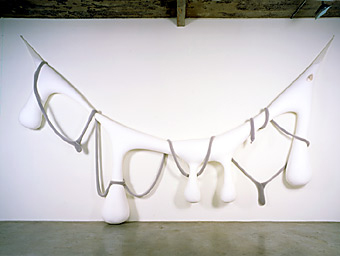
Sometimes my work is not so personal; sometimes you can not touch. My thinking is much more that the body carries the meanings itself. That is critical of our need to find so many meanings to live. There is this desperate need of explanations of everything. I mean, I really love to have explanations, to read things, to know how things work, or different opinions of things, but at the same time, I am kind of critical of this metallization of the planet we live in. I really try to reinterpret nature through my work and think about nature, but think about nature not as painting or landscape, but thinking about it structurally, how one thing in nature deals with the other. How our landscape has been become much bigger. We have a microscope and we can see things inside, and we have a telescope and we can see things outside. I’m interested in this level of breathing, the atmosphere that we have around us, the micro to the macro. And I think what I want when people have a relationship to [the installation], is that they feel that their-selves are there, that the body is something in common to us.
FR: This touches upon something you have spoken about before, about this other tension between nature and culture which you are trying to work out through your work.
EN: I think culture separates us. Nature puts us together again. It is a consolation. Nature is not in the third person. We are nature. I don’t think we are something else because I don’t understand anything else but nature in the whole universe. At least we found a name to call it, and this name is ‘nature.’ And of course we are very different than a dog because we can articulate personality, thinking. But it doesn’t mean that this rationality didn’t come from nature. This is all fruit of nature.
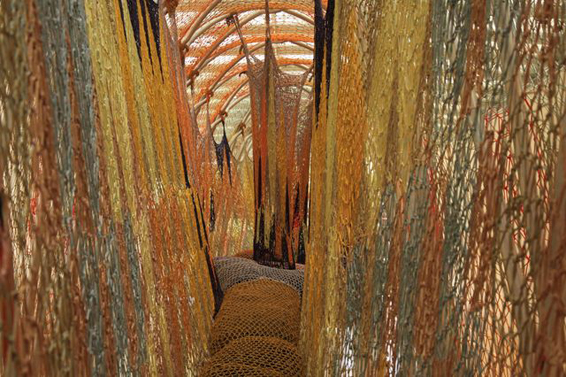 You know I can’t stand this living in a search for death – valorizing death. Like you know, I come from a Catholic family, not very Catholic, but I have been baptized. I hate Christianity. It has made a lot of terrible things in this society. But it is not that I am against someone who is Christian or is Jewish or somebody who is Muslim. Anybody, if they want to have a religion, they can have a religion. But I’m not in favor of religion at all. I think religion is not something to congregate people; it is something to separate people. But just about Christianity, this idea that we have a guy dead – and I have huge respect for Christ – but this idea that death is our orientation, I think life should be our orientation. Everything wants to be alive. That’s why we are here. This planet wants to be alive. It was millions of years of micro organisms mixing with other ones, all this evolution for us to be here now. And we can not just f*cking turn our back to that and look to God and think that we are bigger than that, think that culture is bigger than nature.
You know I can’t stand this living in a search for death – valorizing death. Like you know, I come from a Catholic family, not very Catholic, but I have been baptized. I hate Christianity. It has made a lot of terrible things in this society. But it is not that I am against someone who is Christian or is Jewish or somebody who is Muslim. Anybody, if they want to have a religion, they can have a religion. But I’m not in favor of religion at all. I think religion is not something to congregate people; it is something to separate people. But just about Christianity, this idea that we have a guy dead – and I have huge respect for Christ – but this idea that death is our orientation, I think life should be our orientation. Everything wants to be alive. That’s why we are here. This planet wants to be alive. It was millions of years of micro organisms mixing with other ones, all this evolution for us to be here now. And we can not just f*cking turn our back to that and look to God and think that we are bigger than that, think that culture is bigger than nature.
And that is the feeling I have, and the feeling I have of the arts scene, that nature is more important than culture. And of course culture is super important, but again it is another fruit of nature, another fruit of the weird animal, human being, that is really different than all the other animals, but is still an animal.
FR: This brings up a few things I wanted to touch on, this juxtaposition of nature and culture. Where you are from, Rio de Janeiro, is this city in between these boundaries of the mountains and the ocean. And the culture of the city is so much a part, seemingly – or it could be made out to be, of how you approach your work in terms of community and conversation. I mean, we’re lounging here in a sculpture talking, and not standing around it, which has a tinge of what is, at least stereotypically, a kind of a Brazilian, laid back, kind of more sensual more social environment. Is it too much to make those connections between your country and your city and your work?
EN: You are completely right in all of it. It looks like a stereotype, but I think it is more that it is a consequence. I have to tell you something: we have a civilization and we have a huge nature around. It is like a river where you have the big mountains, the sea, the lake, so there is this floating between civilization and nature. It is something that, maybe if I lived in Paris or San Paolo, I would be able to say that. And also this social thing, I am someone who really goes to the beach. I have many friends on the beach, friends I don’t know their second name. They are not my best friends, but they are nearby and they are going to be at a party at my home. And on the beach you have this thing, you lay down on the sand and you are almost naked. The sand is something like a volume. You have this relation to the sun. You get inside of the water, you are floating too – inside – so everything that you see here in a certain way it comes from there. So we have this socialization. That is what I can bring from there in a certain way. It totally shapes sculpture, shapes our personality.
 Once I was in Paris, and people began to discuss directions with the taxi driver. And they got in a very serious discussion about the way we were supposed to go to the museum. I begin to think about that, and in Paris, you have these big boulevards and this tower where you can see every thing. So I begin to think that these boulevards are like the great French philosophers – Voltaire, Sartre, Descartes. So you have these big philosophers in France, but when you get out of these boulevards it is a mess. You don’t know where you are, you are lost, and there are a lot of streets. So there is a lot of discussion, you keep discussing all the time every little thing. And inLondon, you have a different structure. InLondonyou never go in a straight line – you go here and then you move here – you are never direct. The cafes and the pubs are always hidden, always curtained, and always closed. Everything is like that, hidden. And they never talk to you directly, there is always this kind of twisting. So it is very different than the French, which have these direct lines and this small talk. Then I think that people in Dallas are probably very influenced by the openness here.
Once I was in Paris, and people began to discuss directions with the taxi driver. And they got in a very serious discussion about the way we were supposed to go to the museum. I begin to think about that, and in Paris, you have these big boulevards and this tower where you can see every thing. So I begin to think that these boulevards are like the great French philosophers – Voltaire, Sartre, Descartes. So you have these big philosophers in France, but when you get out of these boulevards it is a mess. You don’t know where you are, you are lost, and there are a lot of streets. So there is a lot of discussion, you keep discussing all the time every little thing. And inLondon, you have a different structure. InLondonyou never go in a straight line – you go here and then you move here – you are never direct. The cafes and the pubs are always hidden, always curtained, and always closed. Everything is like that, hidden. And they never talk to you directly, there is always this kind of twisting. So it is very different than the French, which have these direct lines and this small talk. Then I think that people in Dallas are probably very influenced by the openness here.
So I am very oriented by my background. I think this kind of touching relationship, this kind of informal relationship is very interesting because formality is very rational, social organization can be very much like a machine — how are we doing, should I go this way, you are senior, you are junior. There are a lot of levels to the mechanization of society. This Platonic point of view is very great to make machines, but I don’t know if it is so good to for us to deal with each other. If you are inside of this machine, of this structure, it works. But if something gets in from another culture, then you don’t know what to do.
FR: Do you like the tactile element involved in making your work?
EN: I like to touch. I think that if you have an idea, and when you arrive when you finish, if this piece is exactly what I wanted, I think this is sh*t. Because if you didn’t get nothing from your idea to the result, what’s the point? What’s life? What are you doing, why do you do it? So I think the problem is very much from the idea to the result and what happened along the way. And that is the point of the artist. Of course there is another point. When you finish the work and you put it on the ground, then you have another game: how the society is going to deal with that, what that is going to mean or not for you. This is another game.
FR: With your work there is almost a literalness to that involvement of the audience in the making of the work. As people move through this work, for example, it will shift and alter, however slightly.
EN: It is still alive.
FR: Many of these ideas, of the conflict between rational or geometric forms and nature, about sculpture that conveys a kind of sensuality, they were all very much a part of the Neo-Concretist movement in Brazil of the 1960s. How did you first come into contact with their art?
EN: I probably encountered it before I knew it. Because my father was an engineer, and when I was six years old, he changed his work. He began to get land, build houses and sell them. And that was his business. And my mother, she began to study industrial design when I was born. So we saw a lot of the people who went to make group works; they always went to her house. I saw a lot of things. So I have this architectural background. And she became a landscape designer. But they did not have art that was the very best. They didn’t have neo concrete in their house, but we had that environment. But you would see it on the streets, pieces from Franz Weissmann, Amílcar de Castro, so I begin to get crazy about these pieces. And then more and more – It is very strong. It is so parallel, it is not something that you suddenly see; it grows with you. It is part of my body from when I was born. And then the work of Lygia Clark, which is the most important for me.
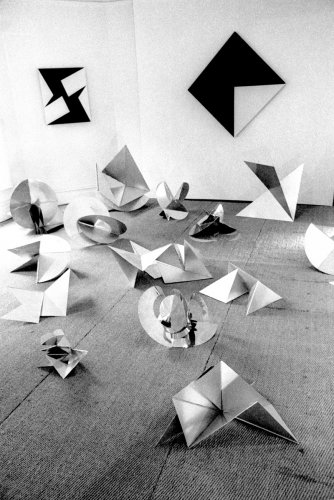
What I think about Neo-Concretism, what we have is a biological construction. This [pointing to his work, Kink] is all geometry. This is spiral, cells; this is the in between the cells. We separate, and we fill it. When I didn’t want to do geometrical works anymore, I was already stretching this style. I wanted to do things more organically. When I make the work with the stockings and the lead beads, I was thinking about making sculpture made of cells, and when you touch it, you get the idea of flesh. Because, you know, I’m a sculpture. I’m really a sculpture. I think through sculpture. I think the talking we are having now is a sculpture in itself. I think the structural organization of a building is a sculpture itself.
The problem is that we are this rational animal, we can’t get out of it. This is also a nightmare, because we are never going to be able to. First about sex, you can not have sex. You cannot have free sex, sex is a problem, but sex can make you crazy. And in the end the society is always trying to label sex as a sin because it can make evolution. If you think aboutTroy, it is a war because the guy got Helena. This is a joke, you know, but it is a symbol. And so, we are this animal; we don’t want to be a machine, but we organize ourselves almost to be like a machine.
When I was young, I thought that old people knew things. I wanted to listen. And I thought, when I get old, I will know. And I’m getting old, man, and I’m not knowing. I feel like all of us are a lot of children with a lot of power in our hands. Can imagine all these presidents – your president, French president, the Brazilian president – they have all this power in their hands, and they don’t know too. So we are on this planet spinning around, and we all don’t know. A lot of people say, ‘Oh, we know,’ so they can control others with that. But I don’t want to control others. I want to know. And I’m never going to know, and we are going to be this animal fighting with this enemy, this rationality. But this enemy is our best friend at the end of the day.
I don’t know where to go, man. Maybe that’s why I make these sculptures. But these sculptures are not going to take you anywhere. I am not an artist that, I think, is very intelligent and that I give a lot of meanings. No, I give a place for you, and this place has a thinking, it has a desire, but it is through yourself in here that you get there. Your answers are inside of you; my answers are inside of me. And maybe all of us together have a knowledge. Imagine if we put all of the brains on earth together, and a paper arrives from it. I don’t know. But the reality is I feel like a child. I feel like a f*cking child full of problems.


